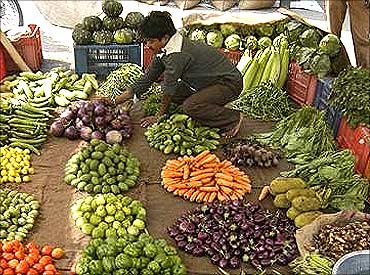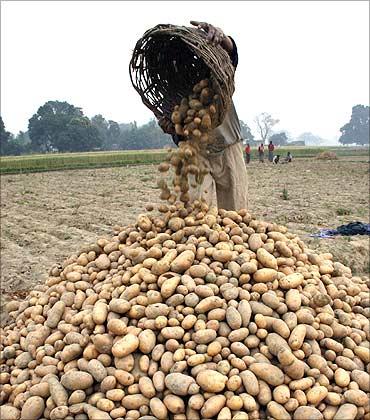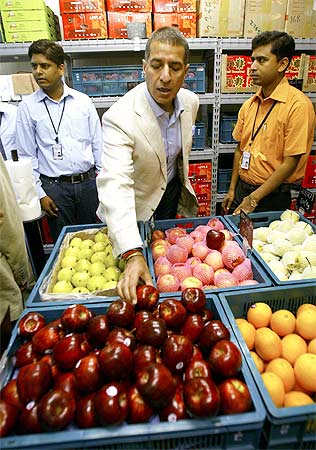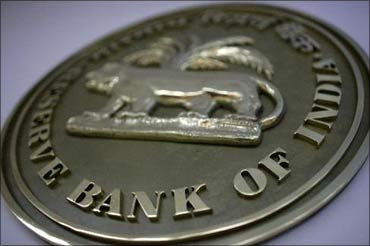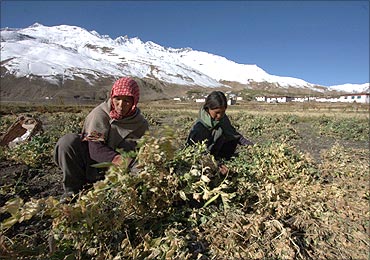 | « Back to article | Print this article |
Food inflation: Govt clueless on how to tackle it
A year ago, poor rains in 2009 were projected as the primary cause.
However, 2010 saw one of the best monsoon performances in several years and yet, the food price inflation has remained in double digits, barring for a month or two.
Within the food basked, the sharpest increase has been in the price of vegetables and fruits, and it is here where the government's cluelessness is most visible.
Other than the usual knee-jerk reactions entailing banning exports of some products such as onions, short-term imports from neighbouring countries, and some tinkering with import duties, there is not much else to show by way of any ground-breaking new idea or action.
Click NEXT to read further. . .
Food inflation: Govt clueless on how to tackle it
Indeed, a deeper analysis of the underlying demand-supply shifts over the last few decades could have given very early warning signals to the successive state and central governments.
But sadly, other than compilation of incomplete, relatively outdated and sometimes unreliable cultivation and production statistics through a plethora of agencies, there has been little reflection on the demand side changes and also on the increasing challenges on supply side.
Challenges include increasing urbanisation which has steadily reduced the area (on the periphery of cities) under cultivation for vegetables in particular, and depletion of groundwater tables in some of the more agriculturally productive states such as Punjab.
Click NEXT to read further. . .
Food inflation: Govt clueless on how to tackle it
Hence, while the gross area under cultivation for horticultural products has increased two-fold in the last 20 years (and output doubled too), the demand has risen much faster on account of the rapid economic growth which has taken almost 300 million Indians out of poverty line even as the population also increased by a similar number (about 300 million).
Hence, effectively, India has to provide for an additional one billion or more meals per day in 2011 compared to what it needed in 1991.
By 2020, India's population will further increase by more than 150 million, and if the economy continues to grow at the same pace as it has in the last 10 years, another 150 million or more may be pulled above the poverty line, requiring an additional 600 million or more meals per day.
Click NEXT to read further. . .
Food inflation: Govt clueless on how to tackle it
Rising incomes also lead to higher consumption of vegetables, fruits, proteins (pulses and meat) and dairy products which again leads to a higher acceleration in demand, beyond just the population increase and addition of more meals per day for those who have just moved above the poverty levels.
With pressure on land increasing every day, it is nearly impossible to have any further dramatic increases in area under cultivation for agriculture in the coming decades.
Water shortages and depletion of water table are likely to put further stress on agricultural output.
Click NEXT to read further. . .
Food inflation: Govt clueless on how to tackle it
Hence, without losing any further time, the government and its planners have to burn midnight oil to come up with bold strategies that can deliver some results in the near, medium and long term.
In the near term, the easiest and simplest actions are just to do with two fundamental policy changes.
One is relating to scrapping of all restrictions on marketing and movement of agricultural and horticultural products within India and eliminating some of the spoilage on account of innumerable stops at various octroi and other check-posts by totally removing such local taxes on perishable produce.
Click NEXT to read further. . .
Food inflation: Govt clueless on how to tackle it
The second relates to encouraging modernisation of distribution and retail system in the country without getting into a totally irrelevant debate on the origin of the massive funding required for this modernisation in the entire farm to customer supply chain.
In the medium term, the solution is to offer hundreds of millions of Indians 'ready to cook' or 'ready to eat' food.
While the government has often spoken about the importance of the food processing industry and efforts have been made to encourage processing of food, it must now come up with some ground-breaking policy initiatives that can generate massive investments into food processing which can take the relatively low-grade raw material output from the Indian farms and convert the same -- preferably at the source of production or very close to it -- into products having higher shelf life and which can be transported to retail outlets without an expensive cold chain.
Click NEXT to read further. . .
Food inflation: Govt clueless on how to tackle it
In the long term, India has to work on a two-fold strategy.
One initiative has to further increase the focus on coming up with new high-yielding seeds, including genetically modified ones, to usher in a quantum increase in productivity.
The second one should be for securing India's food needs through strategic (rather than reactive) imports since it is unlikely that India can achieve food security in future through domestic production alone.
